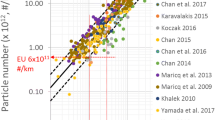Abstract
A method was developed for sizing the particulate filter that can be used inside a sorption-based onboard hydrogen storage system for light-duty vehicles. The method is based on a trade-off between the pressure drop across the particulate filter (during the fill of the H2 storage tank or during its discharge while driving) and the effect of this pressure drop on the usable amount of H2 gas from the H2 storage system. The permeability and filtration efficiency of the particulate filters (in the absence and presence of MOF-5 particulates) was quantified in this study, with an emphasis on meeting DOE’s H2 purity requirements.






















Similar content being viewed by others
Abbreviations
- BOP:
-
Balance of Plant
- CCDC:
-
Cambridge Crystallographic Data Center
- CPI:
-
Cost Performance Index
- DOE:
-
US Department of Energy
- EDX:
-
Energy-Dispersive X-ray
- EERE:
-
Energy Efficiency and Renewable Energy
- EEPS:
-
Engine Exhaust Particle Sizer™ Spectrometer
- FCTO:
-
Fuel Cell Technologies Office
- HIA:
-
Hydrogen Implementing Agreement
- HSECoE:
-
Hydrogen Storage Engineering Center of Excellence
- IEA:
-
International Energy Agency
- MATI:
-
Modular Adsorption Tank Insert
- MOF:
-
Metal Organic Framework
- PTFE:
-
Polytetrafluoroethylene
- SRNL:
-
Savannah River National Laboratory
- UTRC:
-
United Technologies Research Center, East Hartford, Connecticut
References
L. Simpson, Hydrogen Sorption Center of Excellence (HSCoE) Final Report, September, 2010, http://www1.eere.energy.gov/hydrogenandfuelcells/pdfs/hydrogen_sorption_coe_final_report.pdf. Last Accessed 18 Feb 2015
http://www.hsecoe.org. Last Accessed 18 Feb 2015
http://www1.eere.energy.gov/hydrogenandfuelcells/storage/pdfs/-targets_onboard_hydro_storage_explanation.pdf. Last Accessed 18 Feb 2015
M.P. Suh, H.J. Park, T.K. Prasad, D.-W. Lim, Hydrogen storage in metal_organic frameworks. Chem. Rev. 112, 782–835 (2012)
D.J. Collins, H.-C. Zhou, Hydrogen storage in metal-organic frameworks. J. Mater. Chem. 17, 3154–3160 (2007)
L.J. Murray, M. Dinca, J.R. Long, Hydrogen storage in metal-organic frameworks. Chem. Soc. Rev. 38, 1294–1314 (2009)
M. Hirscher, B. Panella, B. Schmitz, Metal-organic frameworks for hydrogen storage. Microporous Mesoporous Mater. 129, 335–339 (2010)
J.L.C. Rowsell, O.M. Yaghi, Strategies for hydrogen storage in metal-organic frameworks. Angew. Chem. Int. Ed. 44, 4670–4679 (2005)
T. Furuta, I. Kanoya, H. Sakai, M. Hosoe, Design of improved metal-organic framework (MOF) H2 adsorbents. Polymers 3, 2133–2141 (2011)
J. Goldsmith, A.G. Wong-Foy, M.J. Cafarella, D.J. Siegel, Theoretical limits of hydrogen storage in metal-organic frameworks: opportunities and trade-offs. Chem. Mater. 25(16), 3373–3382 (2013)
Y.J. Colón, D. Fairen-Jiminez, C.E. Wilmer, R.Q. Snurr, High-throughput screening of porous crystalline materials for hydrogen storage capacity near room temperature. J. Phys. Chem. C 118, 5383–5389 (2014)
J.M. Pasini, C. Corgnale, B.A. van Hassel, T. Motyka, S. Kumar, K.L. Simmons, Metal hydride material requirements for automotive hydrogen storage systems. Int. J. Hydrog. Energy 38(23), 9755–9765 (2013)
M. Veenstra (PI), J. Yang, C. Xu, M. Gaab, L. Arnold, U. Müller, D. Siegel, Y. Ming, Ford/BASF-SE/UM activities in support of the hydrogen storage engineering center of excellence, in Annual Merit Review Proceedings, Hydrogen Storage, June 18 2014
Information Report on the Development of a Hydrogen Quality Guideline for Fuel Cell Vehicles, SAE International Surface Vehicle Information Report, J2719 APR2008, Revised 2008-04
http://www.mottcorp.com/resource/pdf/PSFIBERfinal.pdf. Last Accessed 2 Dec 2015
A. Chaise, P. de Rango, Ph Marty, D. Fruchart, S. Miraglia, R. Olives, S. Garrier, Enhancement of hydrogen sorption in magnesium hydride using expanded natural graphite. Int. J. Hydrog. Energy 34, 8589–8596 (2009)
T.G. Chuah, J.P.K. Seville, Numerical simulation of dust cake build-up and detachment on rigid ceramic filters for high temperature gas cleaning. J. Inst. Eng. (Malays) 65(1/2), 34–42 (2004)
J. Purewal, D. Liu, A. Sudik, M. Veenstra, J. Yang, S. Maurer, U. Müller, D.J. Siegel, Improved hydrogen storage and thermal conductivity in high-density MOF-5 composites. J. Phys. Chem. C 116, 20199–20212 (2012)
D. Thomas, P. Contal, V. Renaudin, P. Penicot, D. Leclerc, J. Vendel, Modeling pressure drop in HEPA filters during dynamic filtration. J. Aerosol Sci. 30(2), 235–246 (1999)
C.B. Song, H.S. Park, K.W. Lee, Experimental study of filter clogging with monodisperse PSL particles. Powder Technol. 163, 152–159 (2006)
B. Hardy, C. Corgnale, R. Chahine, M.-A. Richard, S. Garrison, D. Tamburello, D. Cossement, D. Anton, Int. J. Hydrog. Energy 37, 5691–5705 (2012)
K. Drost, Microscale enhancement of heat and mass transfer for hydrogen energy storage. In Annual Merit Review Proceedings, Hydrogen Storage, 18 June 2014
W.G.J.H.M. van Sark, Introducing errors in progress ratios determined from experience curves. Technol. Forecast. Soc. Change 75, 405–415 (2008)
NIST Reference Fluid Thermodynamic and Transport Properties Database (REFPROP): Version 9.0 (http://www.nist.gov/srd/nist23.cfm. Last Accessed 18 Feb 2015
Acknowledgments
This paper was prepared as an account of work supported by EERE (Energy Efficiency and Renewable Energy) and the FCTO (Fuel Cell Technologies Office) of the U.S. Department of Energy under Contract No. DE-FC36-09GO19006. Neither the United States Government nor any agency thereof, nor any of their employees, makes any warranty, express or implied, or assumes any legal liability or responsibility for the accuracy, completeness, or usefulness of any information, apparatus, product, or process disclosed, or represents that its use would not infringe privately owned rights. Reference herein to any specific commercial product, process, or service by trade name, trademark, manufacturer, or otherwise does not necessarily constitute or imply its endorsement, recommendation, or favoring by the United States Government or any agency thereof. The views and opinions of authors expressed herein do not necessarily state or reflect those of the United States Government or any agency thereof. The authors acknowledge the contribution of the Hydrogen Implementing Agreement, IEA, from which this paper results, specifically the activities of Task 32: H2 Based Energy Storage. Please see www.ieahia.org for more information. The authors would like to thank all members of the HSECoE for stimulating discussions and especially David Tamburello (SRNL) and Bruce Hardy (SRNL) for providing the sorption system capacity as a function of temperature and pressure on which the analysis of the right sizing of the particulate filter is based.
Author information
Authors and Affiliations
Corresponding author
Rights and permissions
About this article
Cite this article
van Hassel, B.A., Karra, J.R. Particulate filtration for sorbent-based H2 storage. Appl. Phys. A 122, 5 (2016). https://doi.org/10.1007/s00339-015-9530-4
Received:
Accepted:
Published:
DOI: https://doi.org/10.1007/s00339-015-9530-4




